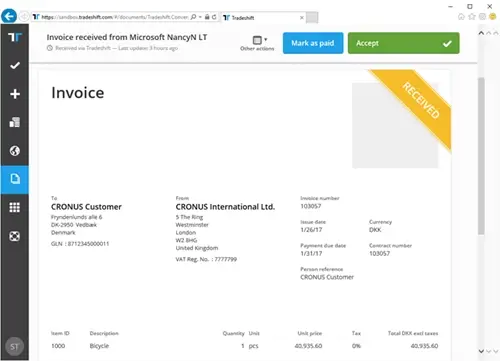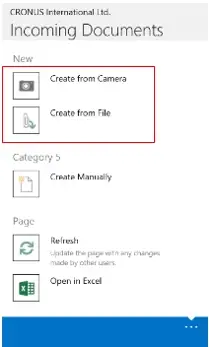Dynamics NAV 2016 is trying to take some of the pain and cost out of going paperless with the introduction of 4 key areas of functionality:
1. E-Invoices
2. Document Management & OCR
3. Automatic Exchange Rate Updates
4. Bank Statement Imports
E-Invoices
There are various challenges when invoicing electronically such as international standards and different vocabulary used within documents.
Dynamics NAV 2016 has now provided support for PEPPOL (Pan-European Public Procurement Online) this is based on United Nations standards and is designed to assist with Business to Government and Business to Business trade.
Documents can now be sent via email, printed, saved file or electronic format. The system also integrates with the Tradeshift network to allow sending and receiving of documents.
v The Tradeshift document interface.

As well as sending invoices electronically they can also be received electronically. When the XML is received the user can manually create a document or journal, alternatively the new workflow functionality embedded in NAV 2016 can be used to automatically create the documents or journals. Text to account mapping allows the users to set up their system to map multiple different descriptions or codes to a single account in NAV.
Exchange Rate Updates
Updating exchange rates for currencies can be a tedious task and if not carried out regularly can leave you exposed to fluctuations with the rate.
Dynamics NAV 2016 allows users to set up their system to automatically update their currency exchange rates from an online XML feed.
There are a number of different feeds available and NAV can be set up to use whichever the business prefers.
Document Management & OCR
As well as receiving electronic files and creating documents within NAV, the new Document Management functionality can be used to receive PDF documents and scanned images of documents in to NAV.
The new NAV 2016 App for tablets and phones also allows the use of the camera to take photographs of documents.
The Lexmark ICS (Invoice Capture Service) integration allows those documents to be changed from an unstructured ‘paper’ format into structured data. Workflows can then be used to create documents and journals within NAV.
The initial ‘paper’ document is also attached to the created document in NAV for auditing purposes.
Lexmark ICS is a Freemium solution that you are given access to with your NAV 2016 license, you can process up to 75 documents per month free of charge and then pay per invoice over that limit.
The new workflow functionality in Dynamics NAV 2016 also allows you to set up approval workflows for any documents created.

Bank Statement Imports
A flexible mapping solution has been introduced in Dynamics NAV that allows the user to map their existing bank's electronic statement format to the reconciliation fields in NAV.
Once the user has downloaded a statement they can import the file to create the bank reconciliation lines, the automatic matching functionality within NAV will then attempt to reconcile those lines to the bank ledger entries that already exist.
The user can see both the statement lines and bank ledger entry lines alongside each other on the screen and can manually make adjustments and matches. This significantly speeds up the reconciliation process, particularly those with large volumes of transactions.







